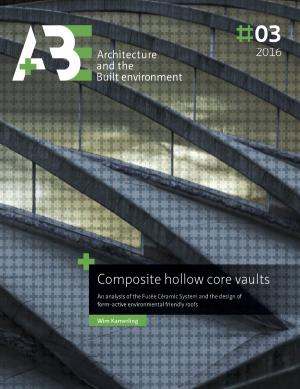Hosted by
Composite hollow core vaults: An analysis of the Fusí©e Cí©ramic System and the design of form-active environmental friendly roofs
Synopsis
Just after World-War II building materials were scarce, architects and engineers had to design buildings using not much cement and steel. In French an architect, Jacques Couí«lle, had invented a system with cí©ramique infill elements to reduce for structures of concrete the self-weight and need of cement and steel. In the fifties and sixties of the twentieth century these cí©ramique elements, known as Fusí©e Cí©ramique elements, were used widely in France, North Africa and the Netherlands, mostly for barrel vaults and shells. Nowadays most of these structures are pulled down and the remaining buildings do not meet the demands of the present concerning climate comfort, insulation and safety.
This thesis analyses the structural design of cylindrical Fusí©e Cí©ramique roofs in the context of those days. The effect of the cí©ramique infill elements for the time dependent deformations, stiffness and load bearing capacity, including second order, is studied. To save the few remaining buildings for the coming generations the possibilities to strengthen these structures with slender light elements of steel are explored. The effect of the strengthening is described for a Fusí©e Cí©ramique vault, designed and constructed in the past.
Reinforced concrete is a widely used building material with many advantages. Unfortunately the production of both reinforcement and cement is quite energy intensive and causes the emission of greenhouse gasses as NO2, NO and CO2. Reducing the need of cement is a relative simple way to reduce the emission of these greenhouse gasses.
In practice roofs are seldom really flat but curved or at least slightly inclined, to drain rainwater and snow. Structurally curved structures, transferring loads as a surface-active or form-active structural system, are very efficient. The need of material and the self-weight is pretty low. This can be very useful if in the future the potentials of roofs for producing food and energy are used more often and these roofs must be designed for much heavier payloads as usual at the present.
For form-active and surface-active roofs of concrete the self-weight and need of steel and cement can be reduced further with light infill elements. This study of the Fusí©e Cí©ramique system shows that infill elements can save cement, self-weight and reduce the environmental load. The possibilities to save cement and reduce the environmental load with infill elements are studied with respect to the construction techniques of the present.
The design of prefabricated cylindrical vaults, composed of segments following a part of a circle and strengthened with slender ties of steel to reduce the bending stresses, is described. To produce prefabricated cylindrical barrel vaults efficiently a positioning of tubes perpendicular to the span is preferable. The effect of this infill concerning the load transfer is analysed. Models of a prefabricated element, with tubes positioned perpendicular to the span, are tested to define the structural bearing capacity of prefabricated barrel vaults.

